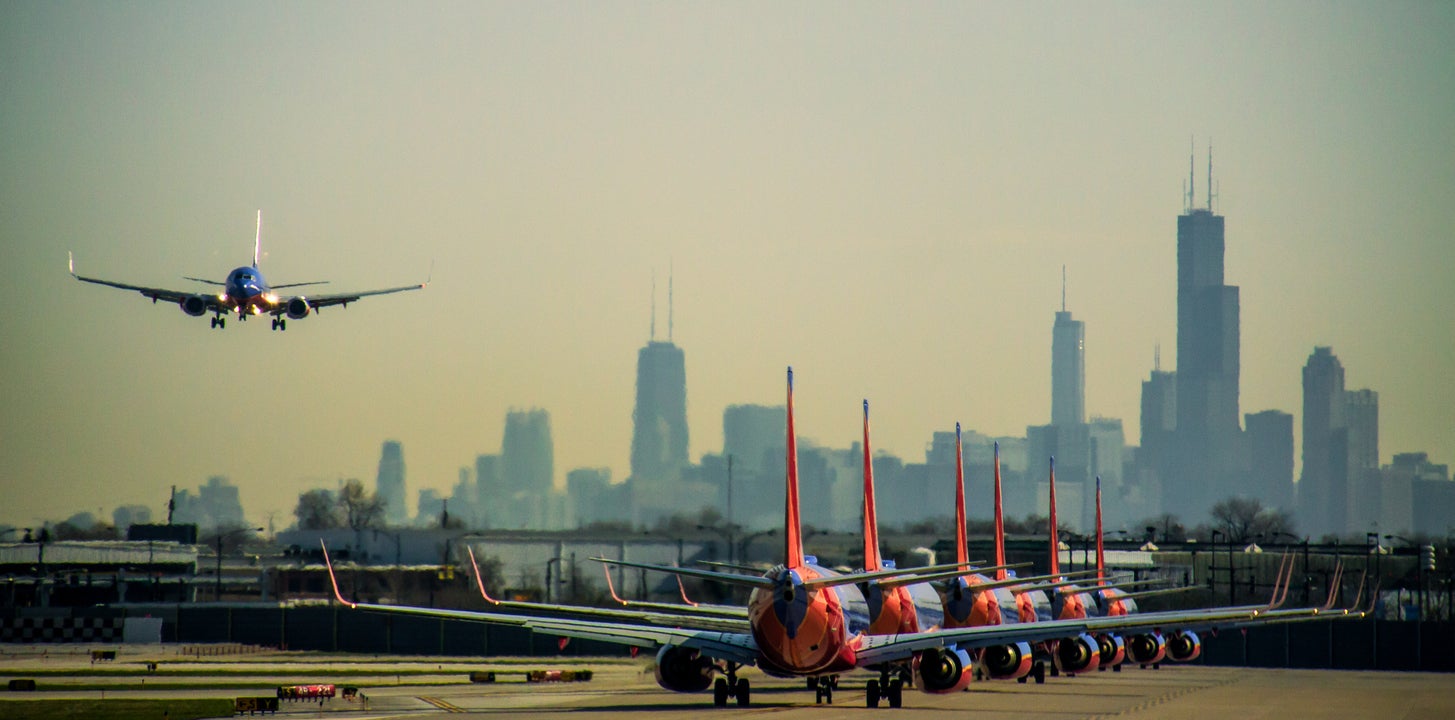Should we be worried about flying to the Middle East?
Simon Calder answers your questions on train strikes, getting from Gatwick to London, Chicago’s best airport, and flying to Abu Dhabi


Q We’re going on holiday to Abu Dhabi in the UAE in February. We saw in the news that easyJet and others have cancelled all flights to the Middle East. Should we be worried?
FB
A I am not sure which news report you saw but, as of the evening of 16 August, easyJet has flown from Gatwick, Glasgow, Liverpool and Manchester to the Egyptian resort of Hurghada, and from Birmingham, Gatwick, Luton and Manchester to the other big Red Sea resort, Sharm el-Sheikh.
Britain’s biggest budget airline is also continuing with its flights to the excellent Cairo gateway of Sphinx international, in competition from Luton with Wizz Air.
If you count those destinations as “Middle East”, then plainly easyJet is flying there at strength. What the budget airline has done is suspend its normal winter programme from Gatwick to Aqaba in Jordan (which personally I think is a shame, because this winter will be a great time to visit the kingdom without the crowds). In addition, this month easyJet extended the suspension of flights to Tel Aviv, the main gateway to Israel, until spring 2025 at the earliest.
For anyone wanting to travel to these countries there are plenty of alternatives. To Aqaba, Royal Jordanian has flights from Stansted and Heathrow to Amman with onward connections to the city at the top of the Gulf of Aqaba.
Tel Aviv has multiple daily flights from London Heathrow and Luton (from where it is facing competition with Wizz Air). I am not suggesting tourists should visit Israel until the Foreign Office lifts its warning against going, but I hope this has shown just how much flying is taking place right now.
Six months is an eternity in Middle East geopolitics, and much can change before your journey to Abu Dhabi. With tension particularly high between Iran and Israel, some nations’ airlines are taking long detours to avoid any possible military activity.
But the UAE and neighbouring nations on the Arabian peninsula are functioning just as normal. February will be a bright and warm time to visit Abu Dhabi, and I cannot think of any reason to cancel.

Q When discussing the pay deal between the government and Aslef, the train drivers’ union, you have quoted a figure of £240 per second as the amount taxpayers are subsidising the railway. Can you show me how you worked that out, please?
Name supplied
A A good question, with an answer that is rather different from the usual kind you find here. Mine is a very specific figure at a time when data untainted by the effects of the Covid pandemic is hard to find. To obtain it, I spent a fair amount of time ploughing through documentation from the Office of Rail and Road (ORR) and the Rail Delivery Group (RDG). I began by looking at the average pre-pandemic operational subsidy. The most recent statistical release, “Rail Industry Finance (UK) 2019-20” is more opaque than I would wish. It specifies “£6.5bn of support for the operational railway” between 1 April 2019 and 31 March 2020.
However, as that period encompasses the start of the Covid crisis, in which rail revenue suddenly collapsed, the figure is inflated. Looking back through previous years, I believe I have pinned down the average annual operational subsidy for the railway as £4.7bn.
Next question: how has this changed since Covid? The RDG says: “Taxpayers are continuing to contribute an extra £54 million a week just to keep services running.” The key word is “extra”, on top of the “business as usual” payout.
Taken together, that represents an annual subsidy of £7.5bn to keep the trains running. That works out at £237.82 per second, which I rounded up to £240. I was content to round the figure up, rather than down because I believe it may somewhat understate the true amount due to the effects of inflation on railway costs. We should find out from the ORR in November how accurate my calculation has proved.
Finally, to be absolutely clear, the figure excludes “funding for enhancements to the existing network” and expenditure on the High Speed 2 project – which, taken together, amounted to a further £4.3bn, or £136 per second, immediately before the pandemic.

Q In October I need a flight from Atlanta to Chicago, where I am lucky enough to be taking part in the marathon. I am looking at like-for-like flights on American Airlines and Frontier. Similar flight times, both with “one carry-on plus personal item”.
I have heard that Frontier check every cabin bag. They are £20 cheaper and also fly into Chicago Midway airport, rather than Chicago O’Hare. Which would you choose?
David B
A All other things being equal, I would naturally go for the cheaper deal. As always in travel, though, not everything is equal. Let’s start with the baggage issue. Standard policy for almost every North American carrier, including American Airlines, is that curious “one carry-on plus personal item”. What it means is that you can bring two items into the cabin without charge: a fairly chunky roll-along case measuring 56 x 36 x 23cm, and a fairly modest backpack not exceeding 45 x 35 x 20cm.
Frontier, an ultra-low-cost airline, allows only the smaller backpack option without paying extra. A roll-along bag or similar comes at an extra fee, which you have clearly factored in. Assuming you are compliant, there is no reason to avoid Frontier. I have flown with the carrier once, from Buffalo to Orlando. I paid for only the smaller backpack, and the ground staff seemed relaxed – it certainly wasn’t placed in a sizer at the gate.
I was impressed with Frontier: a professional operation in the air. We were held on the plane for an irritating 45 minutes on arrival in Orlando because of a ground-handling problem. But as I was finally walking away from the gate, the airline emailed me a $50 (£39) voucher for future travel. (Terms and conditions applied, and it has long expired, but impressive nonetheless.)
As you will be heading downtown for the marathon, the clincher for me is the chance to fly into Midway airport, the original Chicago airport. It is far smaller and more manageable than O’Hare, and retains some of its mid-century charm. Also, the journey to the centre on the CTA train is half the distance and twice as fast.

Q I am coordinating a family group of eight – five adults and three children – on a visit to London next Monday to Thursday. We will be flying in to Gatwick airport and are staying at a hotel on the north side of Hyde Park. What is the optimum way to travel into the city?
Name supplied
A The first law of air-rail transfers is: never take the high-priced express when a slightly slower train is half the price. This applies at Stockholm, Oslo – and Gatwick. A one-way ticket on the Gatwick Express from Gatwick airport to London Victoria costs an outlandish £23, or £20.50 if you buy online in advance. But Southern (all part of the same company, but with green rather than red trains) has four fast trains an hour, stopping in a couple of places along the way and taking two minutes longer, for £14 (after the morning rush hour, which works for the vast majority of arriving passengers). You can save further one-third off each adult fare by buying a GroupSave ticket. In addition, the children can join you for £2 each.
Don’t bother booking ahead online because the eccentric railways of the UK require you to collect the tickets from a machine or just buy at the station. When you reach the well-signposted train station at Gatwick, the staff at the railway station will help you get the right deal. Buy a return ticket so that all the hassle has been dealt with. For the whole group the ticket should work out at £73.25 each way, a not-unreasonable £9.15 per person. There is no need to commit to a specific train: just catch the next one leaving.
On arrival at London Victoria, make your way to Grosvenor Gardens (to the front of the station and left), to bus stop Q. Board bus 148, which should depart at least every 10 minutes. It runs along the whole north side of Hyde Park. Go to the top deck to be able to peek into the back garden of Buckingham Palace, as you go towards Hyde Park Corner. Adults and children over 10 pay £1.75 (with a contactless card – no tickets needed). I realise this looks implausibly complicated, but trust me – it is the optimum arrangement.
Email your question to s@hols.tv or tweet @SimonCalder






Join our commenting forum
Join thought-provoking conversations, follow other Independent readers and see their replies
Comments